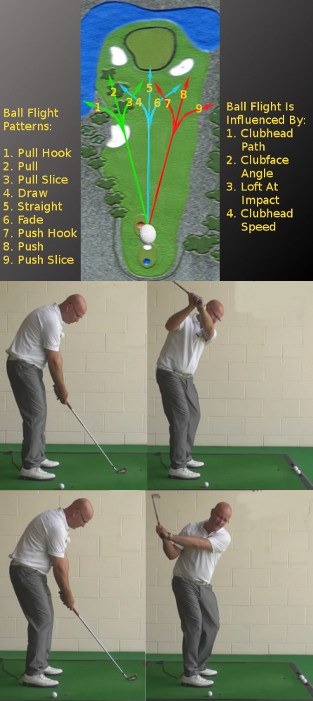
If you understand why a golf ball curves during its flight the way it does then you can massively improve your golf, as this understanding will allow you to diagnose exactly what has happened during impact as the club head struck the golf ball.
You can then work on improving your ball flight as you will know what exactly needs to be improved when you make your next swing.
A golf ball curves during its flight when there is a difference between the direction that the club head is moving in, or the club head’s swing path and the direction that the club face is aiming in. The greater the difference between the club head’s swing path and face aim, the greater the curve that will be seen during the ball’s flight, as the ball spins around an axis that is more tilted. The closer the swing path and face aim, the straighter the shot as there is less tilted axis spin so the ball flies straighter.
To diagnose your ball flight, initially look at the direction that the ball began its flight on, relative to the target and then whether there was a curve or not and in which direction. The club face of your golf club is 85% responsible for the direction of flight of your golf shot.
If you are slicing the golf ball, which means the ball is starting left of the intended target and then curving to the right during its flight and finishing on the right of the intended target, your club face is open or aiming right of your swing path as you strike the ball. But because the ball is initially starting its flight left of the target, the club face is not aiming right of the target, it is actually aiming left of the target but right of your swing path. This starts the ball left of the target but because there is a difference between the club face aim and the swing path direction (the swing path is even more left of the target than the face) titled axis spin is produced and the ball swings and curves to the right during its flight and finishes off target on the right.
If you are hooking the golf ball, your club face is closed or aiming left of your swing path. A hook sees the ball starting on the right of the target so your club face is aiming right of the target as this dictates the initial flight of the golf ball. However, even though your club face is aiming right of the target, your swing path is travelling even further right than where your club face is aiming. So the club face is aiming right of the target but left of your swing path. This starts the ball right of the target but because there is a difference between the club face aim and the swing path direction, tilted axis spin is produced which results in the ball curving to the left during its flight. The ball starts right of target but curves to the left and finishes off target to the left of the intended target.
The next time you are at the range, look at the initial start of the ball flight relative to the target and the curve that is being produced and then you will know where your club face is aiming relative to your swing path and you can begin to adjust these so that your club head travels down the target line to the target with the club face also aiming at the target, allowing you to produce straight golf shots.






